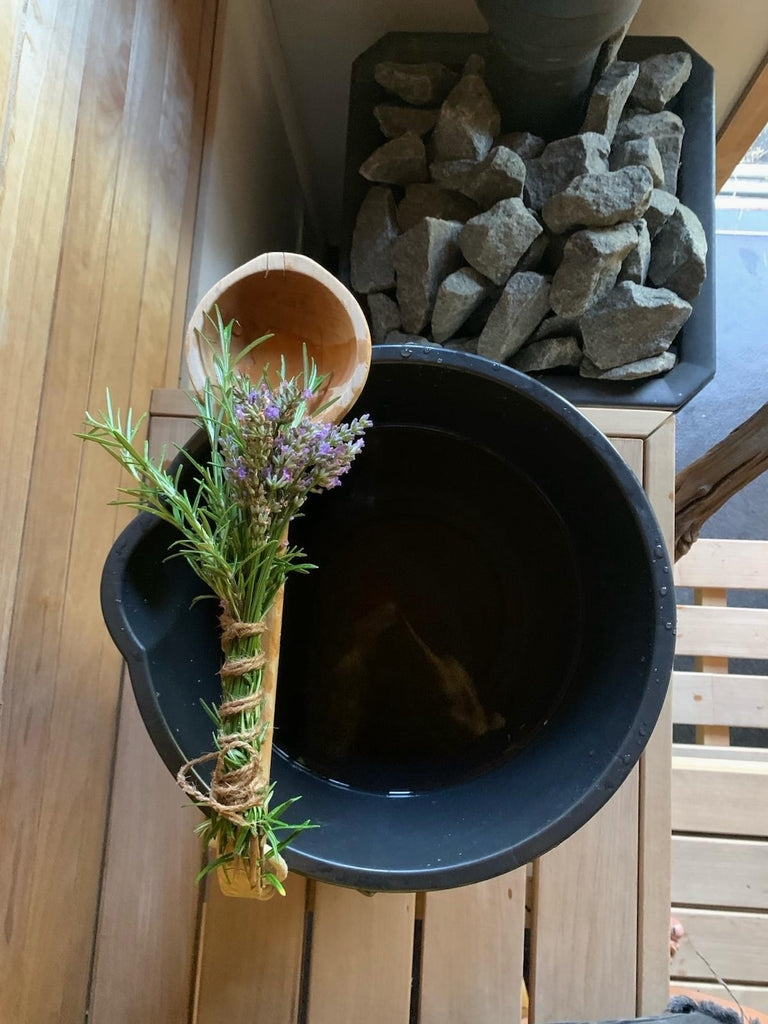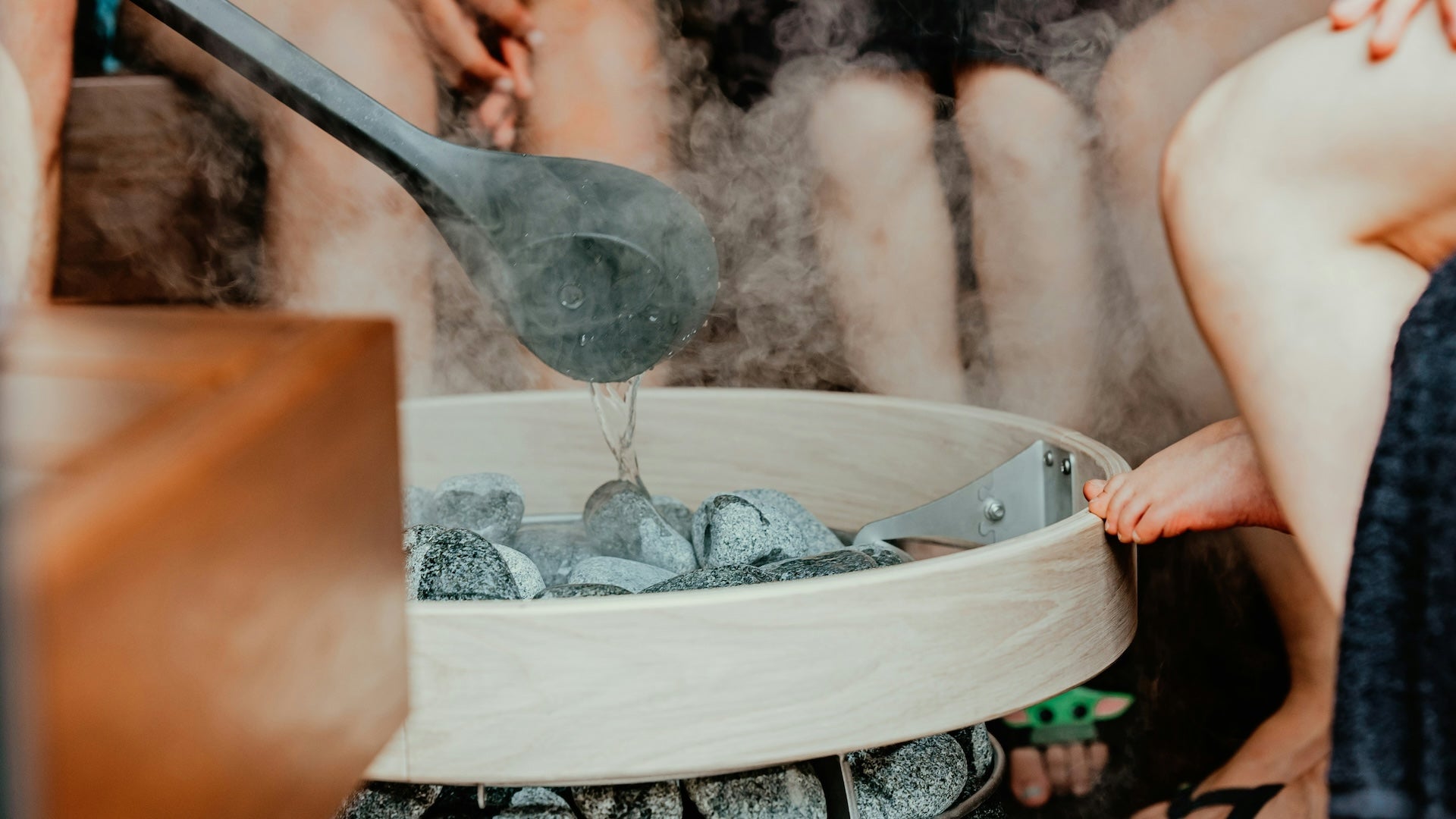In this guest post from Brighton-based community sauna master, Bella Kirkus, we explore how saunaing can be a really effective strategy to improve health, disease resistance, mental wellbeing - and even your social life!

Here in Britain we’re quite new to sauna culture: we’ve got a lot to learn about how sauna can be a strategic and accessible tool to improve health and wellbeing. Most British people’s only experience of sauna is a hot room that you go to after a workout, or relax in after a swim at the pool.
But traditionally, in places where sauna is a part of cultural heritage, sauna was the centre of the community, much like church.
It was where people went to cleanse and heal their bodies, and it was also where they went to birth babies, die, grieve, connect with each other, prepare for marriage, wash their clothes, prepare smoked and fermented foods, and more.
Sauna steam, in Finnish, is called löyly, (pronounced “luoy lu”). It’s hard to translate into English, but it means something like ‘spirit of life’ or ‘essence of life.’ So holistic is the importance of sauna and sauna steam, that it has a deeply spiritual meaning.
To translate this holistic well-being benefit of sauna bathing into self-help strategies for all of us - even those of us new to sauna - we need to begin by understanding some of the practical applications of sauna, looking in turn at the skin, the body and the mind.
How Sauna Looks After Your Skin
In the most obvious way, sauna will cleanse the skin. The heat and steam warm the outer layers of skin, bringing blood supply and nourishment to the tissues of the body, increasing the elasticity of the skin, and lifting the dead cells, promoting new growth.
(Side note: it’s said that the löyly charges the atmosphere with negative ions which cleanse the air. Negative ions also enhance dopamine uptake, so sauna is a very literal antidepressant.)
The traditional products used in a sauna are bunches of birch leaves, which are brushed and gently whacked against the body. This increases blood flow, conducts the heat deeper into the tissues of the body, and delivers the essential oils and saponins in the leaves to the skin. Birch is said to restore the pH balance of the skin, and be mildly pain relieving.
You can double down on the birch effect by drinking tea made from birch leaves, and pouring it on the hot rocks to make a nurturing steam (it smells divine, like a woodland glade!), or even washing with it - birch water is said to strengthen hair as well as skin.

Salt is another traditional sauna treatment. Mixed with honey or carrier oil, a few drops of essential oils, or either fresh or dried herbs and flowers, the salt is gently scrubbed over the body to exfoliate the skin, promoting healthier skin cell regeneration. Many essential oils have powerful antimicrobial, antiviral or antioxidant properties for the skin.
Honey is an extraordinary skin healer: antibiotic, high in vitamin E, mildly exfoliating, and full of natural skin-kind heroes such as propolis, royal jelly and pollen. As well as mixing it with salt for a scrub, you can also use honey to massage the whole body, after a scrub, drink honey water during your sauna, or use it as a DIY face mask.
It should be noted that only the most pure, natural and organic ingredients should be used in a sauna. The heat opens the pores and allows the treatments to penetrate deeply into the body: healing compounds and minerals are absorbed more effectively, as are toxicants. Salt in a sauna should always be natural, without caking agents or iodine.

Sauna & The Body
Sauna-ing connects the processes of the skin to the processing of the internal organs by a process of heating and cooling the body.
A traditional sauna session will comprise heating the body, cooling the body, and resting the body. This will be repeated at least three times. As the body heats, the blood vessels dilate, sending the blood to the skin to cool. And as the blood circulates to the skin, it picks up toxins and other metabolic waste from the muscles and the skin.
When the body has sweated and heated sufficiently, it will be time to cool down, whether with cold fresh air, a shower, dip in the sea or river, or even an ice bath. Any cooling of the body will facilitate this vascular flushing, but immersion in cold water of 12 degrees or lower will have an additional benefit. However, it’s important to remember that you don’t have to force yourself out of your comfort zone!
So this hot/cold movement of the blood from the exterior of the body to the internal organs becomes a mechanism for detoxifying the whole body: oxygen is delivered to all of the tissues of the body, and waste products are carried away.
The movement of blood around the body also gives the heart and the vascular system a workout, flushing out cholesterol and strengthening the whole system. Research has shown how cooling and heating improves heart health and protects against vascular diseases.
Always remember to drink plenty of fluids: warm non caffeinated tea is best - never alcohol! As these toxins are moved around the body and excreted, the internal organs need sufficient fluid to process them
It is important to remember the third part of the sauna session: rest!
In our busy lives, we forget the healing power of rest. The sauna cycle of heating and cooling puts the body into extremes, then rest restores the body to balance; it’s during this rest period that the body's functioning is optimised. It is also where we are restored from the fight and flight of everyday life.
How Sauna Can Help Calm The Mind
According to Trauma Geek unmet needs can have as big an effect upon the nervous system as active, present threat. Loneliness, over- or under-stimulation, or lack of community are perceived by the nervous system as a threat, which can lead to mast cell-related immune compromisation, triggering or aggravating a range of physiological illnesses.
Recovery from cell danger response - where this perception of threat exceeds the body’s capacity for homeostasis - can be addressed by focussing on nervous system support and co-regulation.
Simply put, we can almost literally die of isolation, and the healing of that is being in the company of other people in a safe way.
Sauna is a very sensual environment and this sense-stimulation downregulates the nervous system, while upregulating serotonin uptake. It reminds us to take care of ourselves, to slow down, to enjoy the sensations of our bodies and all of our senses.
It is a gentle way of being in the company of other people, while not stimulating fight-or-flight, as well as potentially processing any physiological and psychological effects of trauma in a very gentle and low-intervention way.

Soul Benefits
Finally, in the same way that it is hard to express the deeper meanings of löyly in the English tongue, it is hard to quantify the spiritual benefits of restoring yourself in the sauna! There is a very special restorative healing that comes from being in your body in a meaningfully shared space.
Practicalities: Making Sauna A Regular Practice
So, how often should you go? How do you find saunas? And is it suitable for everyone?
Well, how often depends upon your budget, it’s said that 4 times a week is good to improve your heart health. Really how often you sauna is up to you; part of the medicine of sauna is letting go of trying to achieve and just be. Once a month could be enough, if that feels good. As you learn more about saunas you find what is your own level, and that usually increases over time because sauna starts to feel essential!
How do you find saunas? Google is your friend in this case. It could be as easy as typing in ‘local wild sauna’ or ‘saunas in my area’. The British Sauna Society website is full of information about the British sauna scene and has compiled a list of ‘authentic’ saunas. And you can find saunas in hotels, gyms and spas everywhere. Obviously, not all saunas are the same - those that work in the industry prefer outdoor, wood-fired saunas because they’re usually staffed by those trained in the art of sauna.
But this can be where you start to fall in love with sauna! It’s such an adventure finding out more. Like restaurants, cafes and pubs, each one has a different vibe, so trying out saunas becomes your new wellbeing hobby.
Finally, is sauna suitable for everyone? Well, almost! In Britain the main prohibition is insurance policies, which do not allow those with high, low or vacillating blood pressure, people who have had strokes, are prone to dizziness, are pregnant, or who have heart trouble.
In fact, there are studies that say that all these conditions can be fine in a sauna, or even benefit from it, but we have not developed our understanding in this country to allow that. Whether sauna is suitable depends more upon how you sauna: the temperature and duration, what your age, current health and familiarity with sauna is, more than whether you do or not. But it is wise to always check with the sauna that you are attending before you book.
The answer is that there is no magic prescription for how, when and how often to sauna. In the same way that there is no one size fits all answer to how often you should run or eat or stay in the sun. There are different ways for different bodies and different traditions! Russian or German sauna is often HOT! Some sauna traditions emphasise longer, cooler sessions.
If there is a prescription, it is to fall in love with sauna. Try all kinds of different ones and read all about it - you’ll find that you develop your own way to sauna, one that best suits your body and what it needs.

Bella Kirkus is an experienced sauna master and director of Stanmer Sauna Garden CIC - which is the UK's second Not For Profit community sauna. She is passionate about developing a modern tradition of sauna that is authentically British but draws upon sauna cultures worldwide. Bella has a particular interest in the therapeutic value of sauna for trauma recovery and general wellbeing. Her values are rooted in inclusivity, sustainability and kindness as a business model.
(Photos by Bella Kirkus, with thanks to @widewatersauna and @saunamasteruk)
Post-Sauna Nourishing Skin Care Suggestions
